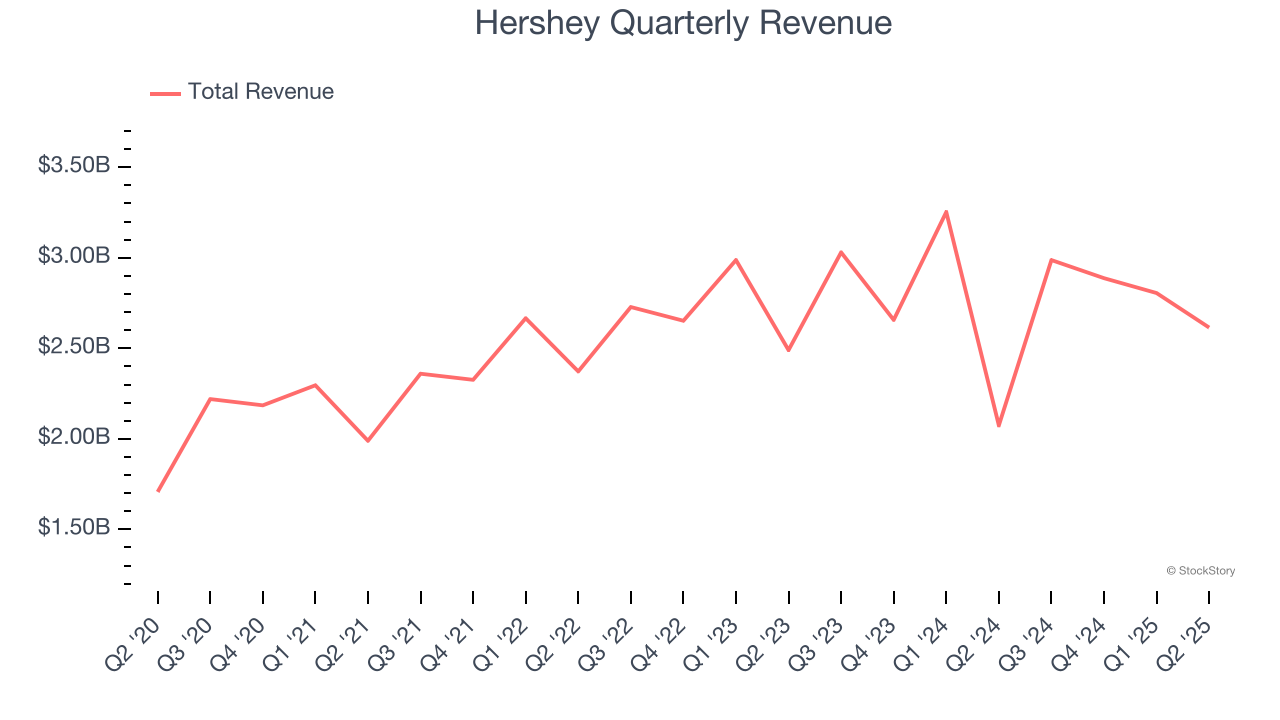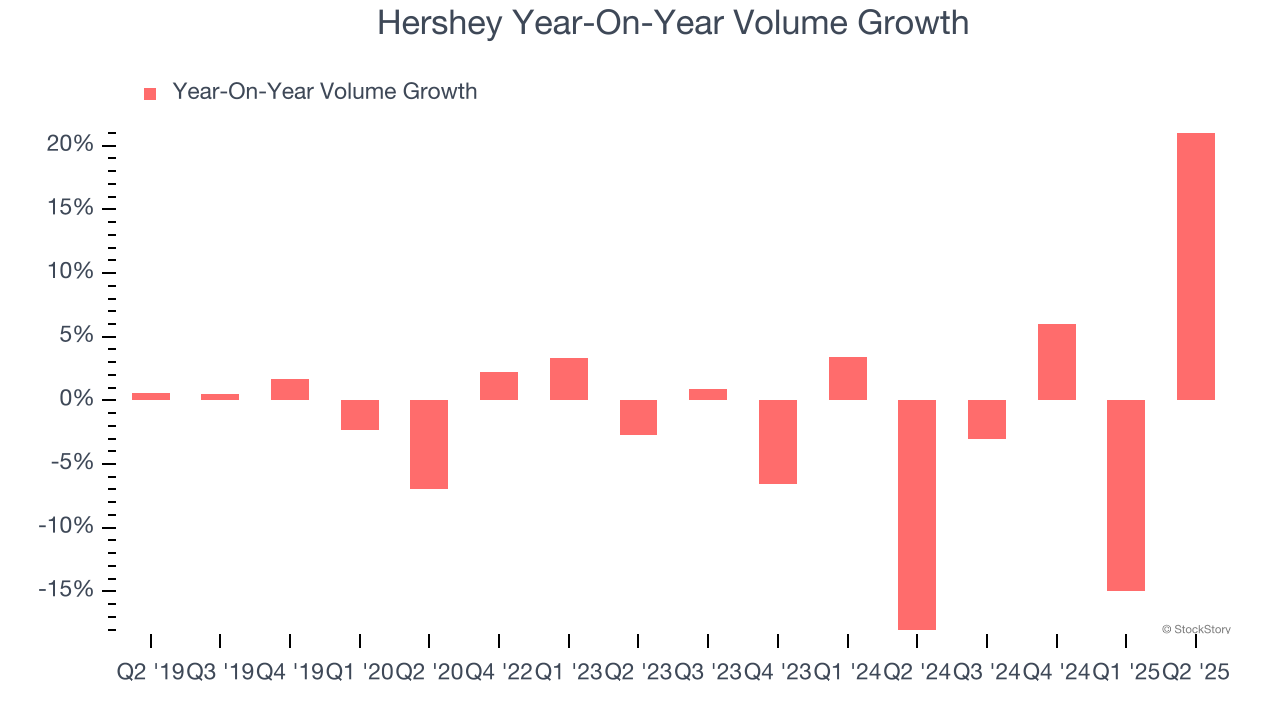
Chocolate company Hershey (NYSE:HSY) reported Q2 CY2025 results beating Wall Street’s revenue expectations, with sales up 26% year on year to $2.61 billion. Its non-GAAP profit of $1.21 per share was 20.4% above analysts’ consensus estimates.
Is now the time to buy Hershey? Find out by accessing our full research report, it’s free.
Hershey (HSY) Q2 CY2025 Highlights:
- Revenue: $2.61 billion vs analyst estimates of $2.54 billion (26% year-on-year growth, 3.1% beat)
- Adjusted EPS: $1.21 vs analyst estimates of $1.00 (20.4% beat)
- Full-year guidance: adjusted EPS down 36-38% year on year, lowered from the "down mid-30% range" previously given
- Operating Margin: 7.4%, down from 13.9% in the same quarter last year
- Organic Revenue rose 26.3% year on year (-16.8% in the same quarter last year)
- Sales Volumes rose 21% year on year (-18% in the same quarter last year)
- Market Capitalization: $37.73 billion
"We are pleased with our second-quarter results and the momentum we are seeing in our business," said Michele Buck, The Hershey Company President and Chief Executive Officer.
Company Overview
Best known for its milk chocolate bar and Hershey's Kisses, Hershey (NYSE:HSY) is an iconic company known for its chocolate products.
Revenue Growth
A company’s long-term sales performance can indicate its overall quality. Any business can experience short-term success, but top-performing ones enjoy sustained growth for years.
With $11.3 billion in revenue over the past 12 months, Hershey is one of the larger consumer staples companies and benefits from a well-known brand that influences purchasing decisions. However, its scale is a double-edged sword because there are only so many big store chains to sell into, making it harder to find incremental growth. To accelerate sales, Hershey likely needs to optimize its pricing or lean into new products and international expansion.
As you can see below, Hershey grew its sales at a tepid 5.1% compounded annual growth rate over the last three years as consumers bought less of its products. We’ll explore what this means in the "Volume Growth" section.

This quarter, Hershey reported robust year-on-year revenue growth of 26%, and its $2.61 billion of revenue topped Wall Street estimates by 3.1%.
Looking ahead, sell-side analysts expect revenue to grow 3.4% over the next 12 months, a slight deceleration versus the last three years. This projection is underwhelming and suggests its products will face some demand challenges.
Software is eating the world and there is virtually no industry left that has been untouched by it. That drives increasing demand for tools helping software developers do their jobs, whether it be monitoring critical cloud infrastructure, integrating audio and video functionality, or ensuring smooth content streaming. Click here to access a free report on our 3 favorite stocks to play this generational megatrend.
Volume Growth
Revenue growth can be broken down into changes in price and volume (the number of units sold). While both are important, volume is the lifeblood of a successful staples business as there’s a ceiling to what consumers will pay for everyday goods; they can always trade down to non-branded products if the branded versions are too expensive.
To analyze whether Hershey generated its growth from changes in price or volume, we can compare its volume growth to its organic revenue growth, which excludes non-fundamental impacts on company financials like mergers and currency fluctuations.
Over the last two years, Hershey’s average quarterly sales volumes have shrunk by 1.4%. This decrease isn’t ideal as the quantity demanded for consumer staples products is typically stable. Luckily, Hershey was able to offset fewer customers purchasing its products by charging higher prices, enabling it to generate 2.9% average organic revenue growth. We hope the company can grow its volumes soon, however, as consistent price increases (on top of inflation) aren’t sustainable over the long term unless the business is really really special.

In Hershey’s Q2 2025, sales volumes jumped 21% year on year. This result was a well-appreciated turnaround from its historical levels, showing the company is heading in the right direction.
Key Takeaways from Hershey’s Q2 Results
We enjoyed seeing Hershey beat analysts’ organic revenue expectations this quarter. We were also glad its revenue outperformed Wall Street’s estimates. On the other hand, its gross margin missed and full-year EPS growth guidance was lowered. Zooming out, we think this quarter had a lot of moving parts and was mixed overall. The stock remained flat at $186.47 immediately following the results.
Hershey had an encouraging quarter, but one earnings result doesn’t necessarily make the stock a buy. Let’s see if this is a good investment. We think that the latest quarter is only one piece of the longer-term business quality puzzle. Quality, when combined with valuation, can help determine if the stock is a buy. We cover that in our actionable full research report which you can read here, it’s free.
